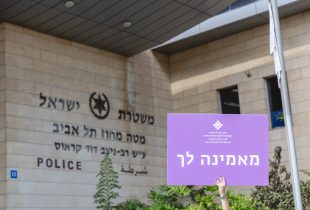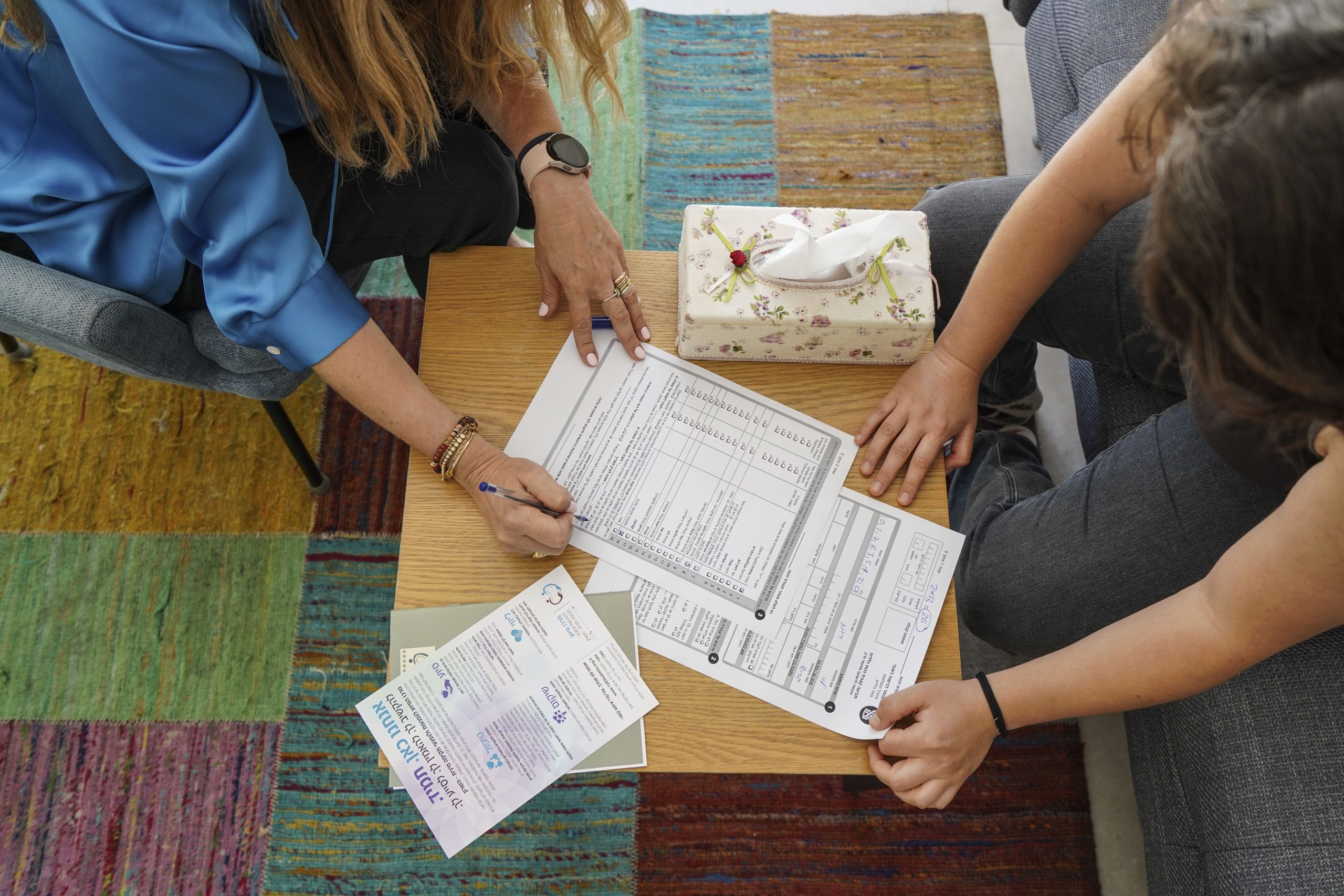אפשרויות פעולה לצד או במקום הליך פלילי
בקצרה
- ההליך הפלילי (המתחיל בהגשת תלונה במשטרה) לא תמיד עונה על הצרכים של נפגעות ונפגעי תקיפה מינית, והוא לא תמיד אפשרי עבורם.
- קיימות אפשרויות פעולה נוספות עבור מי שלא רוצים או לא יכולים לבחור בהליך הפלילי.
- חלק מהאפשרויות רלוונטיות גם במקרה שכן הוגשה תלונה ונפתח הליך פלילי.

למה צריך חלופות להליך הפלילי?
לעיתים קרובות מופנית כלפי נפגעות ונפגעים ציפייה חברתית להגיש תלונה במשטרה ולנהל הליך פלילי נגד הפוגע. הציפייה הזאת נובעת מההנחה שתפקידה של מערכת אכיפת החוק הוא שמירה על הסדר הציבורי וטיפול בפגיעות והתנהגויות שמפרות את הסדר הציבורי ומאיימות על התושבים והאזרחיות.
אבל בפועל, רוב הנפגעות והנפגעים בוחרים שלא להגיש תלונה למשטרה. כ-90% מהפונות והפונים למרכזי הסיוע נמנעו מהגשת תלונה. דוח של המשרד לביטחון פנים מ-2014 העריך שכ-94% מהנפגעות והנפגעים לא יגישו תלונה. לבחירה שלא להגיש תלונה יש סיבות מגוונות, הקשורות בהשלכות הפגיעה, במבנים החברתיים ובקושי להתמודד עם החודרנות והיעדר השליטה הכרוכים בהליך הפלילי. גם במקרים שבהם בחרו נפגעות ונפגעים לאזור כוחות ולהגיש תלונה, הנתונים מראים ש-8 מתוך 10 תיקי עבירות מין נסגרים ללא הגשת כתב אישום, בעיקר בשל היעדר ראיות או התיישנות. בגלל שההליך הפלילי לא תמיד מבטיח צדק עבור נפגעות ונפגעים ולא תמיד נותן את המענה המתאים, קיימים היום מענים נוספים, חלקם ממסדיים וחלקם בחברה האזרחית.
בעמוד זה ניתן למצוא מידע על החלופות הבאות: הליך אזרחי, ביטוח לאומי, משא ומתן, גישור, צדק מאחה, פורום תקנה, הליך התערבות מבוסס קהילה ופרויקט התיעוד.
הליך אזרחי
להבדיל מן הדין הפלילי, המתמקד בהוכחת האשמה ובהענשת הפוגע, מהותו העיקרית של הדין האזרחי-נזיקי הוא פיצוי נפגעות ונפגעים בגין הנזקים שנגרמו להם עקב הפגיעה, שנושאים תג מחיר כלכלי (למשל הוצאות על טיפול, פגיעה בחיי המשפחה ופגיעה בפוטנציאל ההשתכרות). תביעה אזרחית-נזיקית ניתן להגיש במקביל להליך פלילי, לאחריו, או ללא כל קשר לקיומו.
בהליך אזרחי הנפגעת או הנפגע הם אלה שתובעים את הפוגע, להבדיל מהליך פלילי, שבו המדינה אחראית על העמדת הפוגע לדין. התביעה האזרחית מאפשרת להתעמת עם הפוגע תוך הכרה של מערכת המשפט, אבל השליטה בניהול התיק נשארת בידי הצד התובע ולא עוברת למשטרה ולפרקליטות. בנוסף, ניתן לתבוע גורמים נוספים שאחראיים לפגיעה, כמו מוסד חינוכי, דתי וכו’.
לצד יתרונותיו, ההליך האזרחי נתון כמו ההליך הפלילי לפרוצדורות ולכללים הסבוכים של המערכת המשפטית. נוסף על כך, בשל הצורך לשכור עורכת דין באופן פרטי, יש חסמים כלכליים שמונעים פעמים רבות מנפגעות ונפגעים להגיש תביעה בדרך זו.
לקריאה נוספת: תביעה אזרחית בגין עבירות מין.
ביטוח לאומי
המוסד לביטוח לאומי מכיר בפגיעה מינית לצורך קבלת קצבת נכות כללית. הקצבה היא קצבה כספית חודשית, זמנית או קבועה הנקבעת על פי אחוזי הנכות וכושר ההשתכרות שנקבעים על ידי הביטוח הלאומי. נוסף על הקצבה אפשר לקבל מהביטוח הלאומי סיוע בשכר הדירה, הנחה בארנונה, שיקום תעסוקתי, מלגות לצורך לימודים ועוד. הכרה של ביטוח לאומי בנזקי הפגיעה המינית וקבלת הסעד מהווים בעצם מעין הכרה רשמית של המדינה בכך שהתרחשה פגיעה מינית ובהשלכות הקשות שלה על הנפגע או הנפגעת.
מידע נוסף על זכויות נפגעות ונפגעים בביטוח לאומי אפשר לקרוא כאן, או באתר הביטוח הלאומי.
משא ומתן
משא ומתן מתנהל על פי רוב באמצעות עורכות-הדין של הצדדים, במטרה לגבש הסכמות לפתרון הקונפליקט בין הנפגע או הנפגעת לפוגע ו/או לארגון/מקום העבודה. ההסכמות יכולות לכלול פיצוי כספי, הכרה באחריות על העוול שנעשה והסדרים אחרים, הנוגעים לממשקים שבין הנפגע או הנפגעת לפוגע.
בשלב הראשון, פונה עורכת-הדין אל הצד השני (לרוב הצד של ה”פוגע”) ומודיעה כי היא מייצגת את הנפגע או הנפגעת, ומציעה לנהל משא ומתן ישיר כדי לייתר את הצורך בניהול הליך משפטי. בהמשך, אם הצד השני נותן הסכמה לניהול השיח, עורכות-הדין מנהלות את המגעים, הכוללים הצעות חליפין, התנגדויות וכו’ – שסופם בגיבוש הסכמות או ויתור על דרך זו.
כאמור, המשא המתן מתקיים באמצעות נציגות הצדדים (עו”ד), כאשר הצדדים עצמם, כלומר הנפגע או הנפגעת, הפוגע ומעורבים אחרים לא לוקחים בו חלק. לאורך התהליך עורכת-הדין של הנפגע או הנפגעת תשתף בנעשה, ותתקדם במשא ומתן לפי רצונם. התקשורת בין הנפגע או הנפגעת לצד השני מוגבלת, ולא כוללת שיח ישיר, אלא רק באמצעות המסננת של עורכת-הדין. חשוב לציין כי אם התהליך אינו צולח, המשכו יכול להתנהל במערכת המשפטית.
משא ומתן בין עורכות-דין יכול לענות על הצרכים של נפגעות ונפגעים באופן חלקי. במסגרת המשא ומתן הם יוכלו לזכות בהכרה מסוימת בפגיעה ובסעד כספי או אחר. ההליך יכול להיות מהיר מאוד ולספק לנפגע או לנפגעת את מה שרצו מבלי שיצטרכו להתמודד עם פרוצדורות המערכת המשפטית – לעמוד על דוכן העדים, להיחקר על ידי הפוגע וכו’. עבור חלק מהנפגעות והנפגעים, סעדים אלו בתנאים אלו עשויים להיחשב כהשגת צדק. יתרון אפשרי נוסף הוא שמירה על פרטיות, והימנעות מחשיפה בלתי נשלטת או מבוקרת של המקרה.
יחד עם זאת, יש לציין את מוגבלותו הטבעית של ההליך וחוסר היכולת לתת במסגרתו מקום לשיח בין אישי המאפשר לנפגע או לנפגעת להתעמת עם הפוגע. נראה כי מהלך שכזה מתאים לנפגעות ולנפגעים המבקשים לזכות בסעדים כספיים והסדרים הנוגעים להתנהלות עתידית במסלול עוקף מערכת המשפט, ומבלי שיצטרכו להתמודד עם מפגש עם הפוגע או לנהל שיח רגשי הקשור לפגיעה.
גישור
גישור הוא הליך ליישוב סכסוכים, במסגרתו צד שלישי מנהל תהליך של משא ומתן שמטרתו לנסות ולגבש פתרון המוסכם על הצדדים. הצדדים עצמם – הנפגע או הנפגעת, הפוגע ו/או מקום העבודה או מקום אחר במסגרתו התרחשה הפגיעה, לוקחים חלק בדיונים – לרוב בליווי עורכות-דין. התהליך מתקיים בהסכמת הצדדים ומרצונם החופשי, כאשר למגשר אין סמכות להכריע בסכסוך. הליך הגישור יכול לכלול מפגש פיזי בין הנפגע או הנפגעת לפוגע ויכול להתקיים ולהתקדם ללא מפגש שכזה, בנוכחות עורכי הדין שלהם בלבד. הליך הגישור מתמקד לרוב בהשלכות הפגיעה ובפיצוי כספי. הליך זה אינו מצריך פניה לבית המשפט אך לעיתים מופנים אליו לאחר הפנולהתקדם ללא מפגש שכזה, בנוכחות עורכי הדין שלהם בלבד. הליך הגישור מתמקד לרוב בהשלכות הפגיעה ובפיצוי כספי. הליך זה אינו מצריך פניה לבית המשפט אך יה להליך המשפטי. ההליך מבוסס על הסכמה ולכן מאפשר שליטה ויכולת בחירה מסוימת.
מודלים מסוימים של הליך הגישור, בהם גישור טרנספורמטיבי, גישור הומניסטי וגישור נרטיבי, מציעים כלים מפותחים יותר לניהול השיח הרגשי והמורכבות הכרוכים במקרים של הטרדות ופגיעות מיניות.
לעיתים משתתפים בגישור גם קרובים אחרים של הנפגע או הנפגעת ושל הפוגע. בחלק מהמקרים חלק או כל הפגישות נערכות בנפרד, ללא מפגש משותף בין הצדדים תוך ניסיון להתאים את אופן התנהלות המפגשים למקרה ולצרכים של המשתתפים בו. מטרת הגישור היא הגעה להסדר המקובל על הצדדים. התהליך אורך לרוב בין חודש לשלושה חודשים.
באופן עקרוני, הגישור אינו תהליך טיפולי, ולא יורד לרבדים העמוקים של הפגיעה. יתרונותיו על פני ההליך המשפטי הם יעילות, חיסיון, מהירות יחסית, ופוטנציאל לענות על הצורך של הנפגעות והנפגעים בהכרה.
חלק ממי שעברו תהליכי גישור מתארים אותם כחוויה חיובית שאפשרה לקבל מענה לצרכים באותה עת. אחרים מתארים הליך מוצלח בעיקרו, אך כזה שמסתיים ללא עיבוד רגשי מספק, עימות עם הפוגע ו- CLOSURE.
צדק מאחה
צדק מאחה היא גישה המבוססת על ההכרה כי מעשה הפגיעה מהווה קודם כל פגיעה באנשים ובמערכות יחסים, ולפיכך משליך על ממדים אישיים וחברתיים רבים. הגישה מגדירה בצורה רחבה את “נפגעי העבירה” כמי שנפגעו באופן ישיר או עקיף מהמעשים, כך שבהגדרה נכללים גם בני משפחה, חברים וחברי קהילה שהושפעו מן המעשה. הפרקטיקות השונות החוסות תחת הרעיון של הגישה, כוללות מפגשים בהם לוקחים חלק או כל המעורבים אשר הושפעו ממעשה הפגיעה. הדיאלוג המתקיים במסגרת המפגשים מתבסס על שיח רגשי על אודות הפגיעה והשלכותיה, ובסופו המשתתפים בונים הסכמות בנוגע לאיחוי הנזקים שנגרמו. תהליך צדק מאחה מורכב ממספר פגישות אישיות עם המשתתפים השונים לקראת פגישה משותפת בה מתקיים שיח המתמקד בפגיעה והשלכותיה וחותר להשגת הסכמות בין הצדדים, אשר מכיל במקרים רבים גם פיצוי כספי של הנפגע או הנפגעת.
להבדיל ממו”מ ותהליכי גישור, לתהליכי צדק מאחה יש תנאי מקדים: הפוגע מוכרח להכיר באחריותו לפגיעה, ולהביע נכונות להשתתף בו באופן רצוני. בשל התנאי המקדמי של הכרה באחריות לפגיעה ומאפייני ההליך הגמישים שניתן להתאים לצרכים של נפגעים ונפגעות, נטען כי זהו הליך שיכול להיות מעצים ולאפשר להשיג צדק בעקבות הפגיעה. מחקרים שונים שנעשו בתחום מצביעים על שביעות רצון של הנפגעות והנפגעים שהשתתפו בו.
יחד עם זאת חשוב לציין כי מאפייני ההליך (הכרה של הפוגע במעשה והסכמה שלו להשתתף בתהליך) הופכים אותו להליך שמתאים לחלק מסוים מאוד מכלל המקרים והוא לא מתאים בכל המקרים של פגיעה מינית.
בשנים האחרונות האפשרות של תהליכי צדק מאחה במקרים של פגיעה מינית תופסת מקום נרחב בשיח על מענים נוספים במקרה של פגיעה מינית, כך למשל בדוח ועדת ברלינר לבחינת מצבן של נפגעות ונפגעי תקיפה מינית במערכת אכיפת החוק, אחת מההמלצות המרכזיות הייתה פיתוח מענה של תהליכי צדק מאחה במקרים של פגיעה מינית.
פורום תקנה
פורום תקנה הוקם בשנת 2003 בידי גדולי תורה, אנשי ונשות חינוך, משפט וטיפול כדי לפעול למניעת פגיעות מיניות על ידי בעלי מרות וסמכות בציבור הדתי, ומתוך הכרה שאין מענה טיפולי הולם המותאם לקהילה.
הרכב הפורום המגוון: רבנים מכל גוני הקשת של הציבור הדתי-לאומי לצד משפטנים בכירים, מטפלים רגשיים ונציגים מכל רשתות החינוך הרלוונטיות, מקנה לו לגיטמציה ציבורית בקרב הציבור הדתי.
תלונות המוגשות לפורום נבחנות על ידי הוועדה המקצועית, שמחליטה האם יש מקום לטפל בתלונה במסגרת הפורום. אם התשובה חיובית, ההרכב מזמין את הנפגע או הנפגעת להשמיע את דבריהם. לאחר מכן, במידת הצורך, נשמעים עדים נוספים או מובאות ראיות נוספות. בהמשך מזמין ההרכב את הפוגע, מתאר לו את התלונה ושומע את תגובתו. ההרכב דן במקרה, ומחליט כיצד יש לנהוג כדי למנוע פגיעות נוספות באמצעות הנחיות שניתנות לפוגע. ההרכב עוקב אחר קיום ההנחיות. במקרים שבהם הפוגע לא משתף פעולה ולא מושגת הסכמה לגבי דרכי הפעולה למניעת פגיעות נוספות, מפרסם הפורום את מעשיו של הפוגע ומזהיר את הציבור מפני התנהגותו.
חשוב לציין כי הפורום מטפל רק בפגיעות שנעשו ע”י א/נשים שהינם בעלי מרות וסמכות ניהולית, רוחנית או חינוכית, ודיוניו נשמרים בסודיות.
נפגעות ונפגעים שפנו לפורום תקנה תיארו חוויה חיובית ומעצימה ותחושה שנעשה צדק. הם תיארו כי קיבלו הכרה בפגיעה וחשו כי מטפלים במקרה שלהם. לרוב, פונים הנפגעות והנפגעים לפורום מתוך תחושת אחריות קהילתית, רצון למנוע פגיעות נוספות וצורך לקבל הכרה בפגיעה מגורמים משמעותיים בקהילה.
לקריאה נוספת: פורום תקנה
הליך התערבות מבוסס קהילה
תהליכי התערבות מבוססי קהילה מאפשרים לקהילות דוגמת קיבוצים או מושבים או קהילות בלתי פורמליות לטפל באירועים של פגיעות מיניות בלי לפנות לערכאות משפטיות או לערכאות חיצוניות אחרות. התהליכים מבוססים על ההנחה כי הקהילה, שבה חברים הן הצד הנפגע והן הצד הפוגע, יכולה לקחת על עצמה את האחריות לטפל בשני הצדדים באופן מכיל ולא “מרחיק” תוך שאיפה לשלבם חזרה בחיק הקהילה.
ההתערבות נועדה לאפשר את עיבוד האירוע והיא כוללת מפגשים עם המעורבים השונים ועם דמויות משמעותיות בקהילה, שיח על משמעות הפגיעה והאופן שבו השפיעה על חברי וחברות הקהילה. בהמשך התהליך מתקיים מפגש משותף בו מגבשים הסכמות הנוגעות לדרכי התנהלות בתוך הקהילה, ולעיתים מוסכם גם תשלום פיצוי.
התהליך מנוהל לרוב בידי אשת מקצוע מתחום הטיפול, המתמחה בטיפול במקרים של פגיעה מינית. היא מלווה את הקהילה בטיפול בצורה אינטנסיבית במשך מספר חודשים, ולאחר מכן לפי הצורך.
לקריאה נוספת: ליווי קהילתי בעקבות פגיעה מינית
פרויקט התיעוד
פרויקט התיעוד של סיפורי החיים של נפגעות ונפגעי תקיפה מינית, הפועל במרכז הסיוע לנפגעות ולנפגעי תקיפה מינית בתל אביב, הוא ארכיון החדש, הראשון מסוגו בעולם, שבו נעשה שימור של עדויות מוסרטות של מי שחוו תקיפה או פגיעה מינית. מטרת המאגר היא לייצר מרחב בטוח לסיפורים אישיים הנחווים ככאב אישי חבוי, אך מבטאים תופעה חברתית רחבה ומושתקת.
מידע נוסף על פרויקט התיעוד אפשר לקרוא כאן.
Last updated: 03.07.2025







